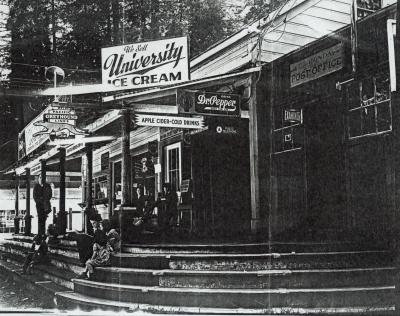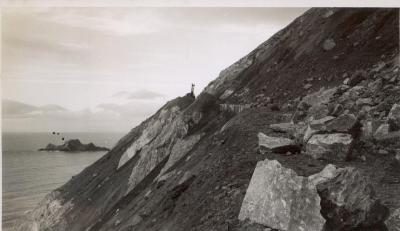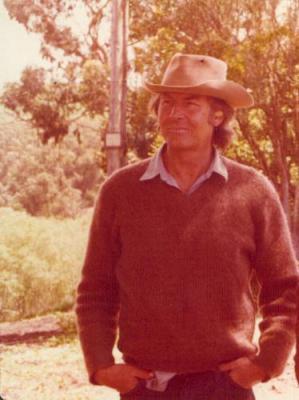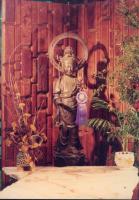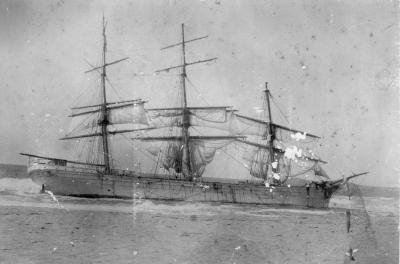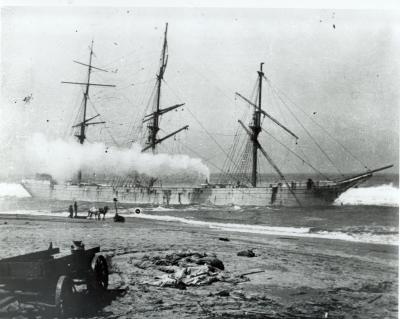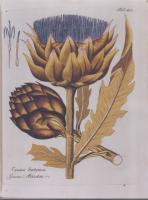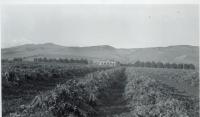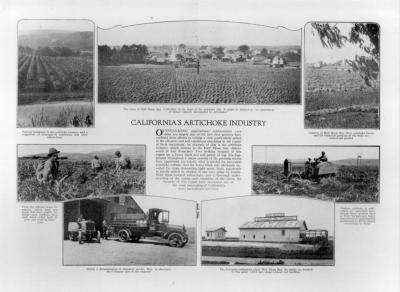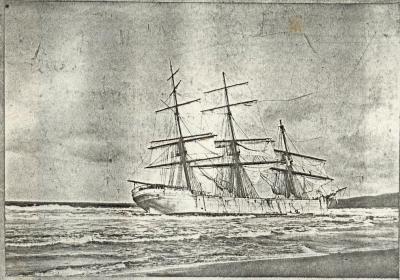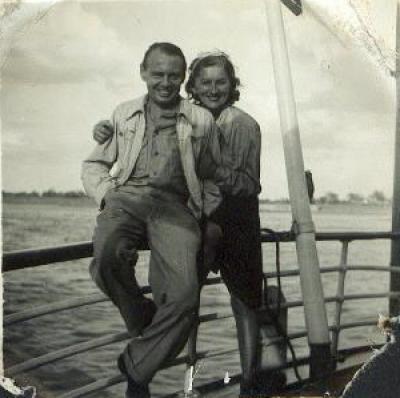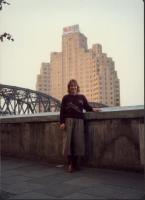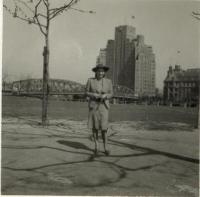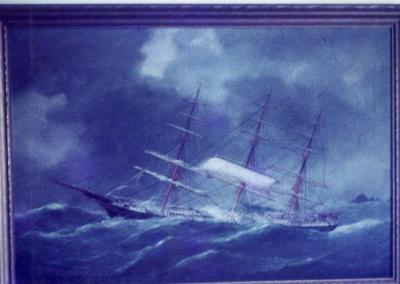Intermission: Falling Rocks Close Devil’s Slide
Commuting Coastsiders are holding their breath….but officials say it’s only temporary, a matter of hours– intermission time at Devil’s Slide.
I guess you should know that I will miss the old Devil’s Slide route. Thinking about getting stuck in traffic inside a tunnel makes me feel helplessly claustrophobic. I hope they put in skylights and picture windows!
(Photo above shows a rock slide at Devil’s Slide decades ago)
In the mid-1990s storms closed Devil’s Slide for several months. Closed the road. With my friend and neighbor, Peter Logan, we drove as close as we could get to the “Slide”, parked the car and walked the rest of the way, a thrilling experience. Then we could go no further–Peter’s photo shows the reason why:
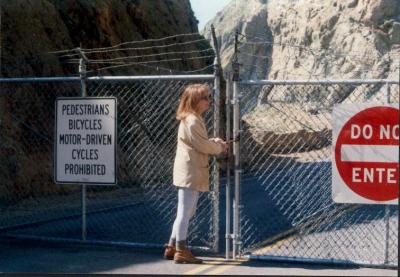
Visit the Coastside in 1946
âDown the Ocean Shoreâ?*âFrom “San Francisco: A Chapter in Your Life”, a pamphlet encouraging people to visit California after WWII, published by Californians, Inc, 1946. I inserted the photos by R. Guy Smith.
(âS1â? = Highway 1âautomobile tour begins near Sharp Park, Pacifica, then proceeds south to Half Moon Bay and Pescadero).
.â? â¦On S1 you follow in reverse the way of the Portola expedition up coast in 1769, expedition that discovered San Francisco Bay, led to settlement of San Francisco in 1776.
“Near mouth of San Pedro Creek, 8.1 m, guarded by lofty San Pedro Point, Portola expedition camped by an Indian village Oct. 31, feasted on mussels pried from rocks. Portola sent Sgt. Ortega with party to scout eastward. As they climbed to top of ridge they saw vast expanse of San Francisco Bay, never before seen by white men. Here, in Pedro Valley, begin fields of silver-green artichokes which supply bulk of this delicacy for nation.
(Photo at right): Montara Lighthouse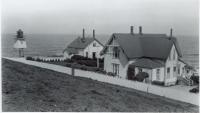
“Montara, 12.3m, with its Lighthouse, U.S. Navy Radio Compass Station and U.S. Navy Anti-Aircraft Gunnery School, is a land checkered with fields that supply as many as 20,000,000 blossoms of everlasting flowers annually. Coast from this point on is said to closely resemble that of Bay of Biscay. Off-shore from cluster of houses that makes Moss Beach, 13.6m, are strangely beautiful marine gardens.”
(Photo at left): anti-aircraft gunnery school
(Photo at right): “Marine” gardens at Moss Beach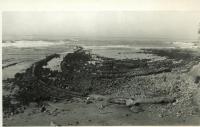
…to be continued…
I’m worried about Tony….
Soprano, that is.
Star of the HBO hit, The Sopranos.
For almost two weeks now, Tony has been lying in a hospital bed hooked up to a gaggle of life-saving equipment. With a huge ugly hole in his stomach from the bullet wound inflicted by his senile Uncle Junior.
Tony’s in an induced coma. Last week all I saw from my side of the hi def screen was his big chest rising and falling as some medical machine helps him to breathe. Emotionally drained wife Carmella, and son, Anthony, and daughter, Med, visit; together or separately they sleep in the room with “Tone”– they talk to the unconscious body in the hospital bed and they play his favorite rock ‘n roll tunes.
But Tony’s dreaming. He’s dreaming a weird story about some guy who’s accidentally taken his identiy– when, through a mix-up at a bar, far from home, this guy picked up Tony’s briefcase (identical to his own), the briefcase filled with Tony’s credit cards, driver’s license, etc. How’s he going to get on the plane without showing his driver’s license, he asks Carmella during a frustrating phone call. That’s what he’s dreaming about…
From the beginning, from the very first show, I became a Sopranos fan. And the family became very real to me.
A couple of Soprano seasons ago, Tony was cheating on Carmella with a beautiful, young Russian lover, and his wife found out and her price for peace was a summer vacation in Rome. With her girlfriends. Where was she going to stay? She told us tv viewers that she was going to stay at the elegant Hassler Hotel.
The Hassler is not a made-up hotel for tv–it’s a real hotel, set high on a hill.
A few months later we (Burt & I) were traveling to Europe, to Italy, and where did I want to stay? The Hassler Hotel–that’s where Carmella stayed, I remembered.
And when we arrived at the Hassler and were enjoying a drink in the intimate patio, I summoned the courage to ask our waiter: “Did Carmella Soprano stay here?”
He looked at me cockeyed. I couldn’t believe it. “You know,” I said gently, but with a bit of a push, “The Sopranos, the HBO show…Tony’s wife, Carmella, said she staying here for the summer.”
He had no idea what I was talking about. Not even the great HBO rang a bell.
Later an American friend who lives in Europe emailed me asking about the Sopranos. At that time it wasn’t on tv over there, he said, and he knew it was a hot cable series. When he was in New York he’d seen a few of the early episodes. He was anxious to talk about the characters and the plots. Could I tell him what the current episodes were about?
Which brings me back to Tony lying in a coma in that hospital bed. I hope he’s okay, I hope he’s doing fine. I hope he’s going to live.
Update: Did I hear right? In the last or next-to-the-last episode of the Soprano’s 2006 season, did I hear Carmella say to Tony that she never got to Rome? Never got to Rome that summer several episodes earlier? No wonder nobody knew who Carmella Soprano was when I was staying at the Hassler Hotel. Mystery solved.
RIP: Channing Pollock
Anniversary of the Shipwreck of the New York at Half Moon Bay (longer version) Part IV
After Captain Peabody telegraphed the New Yorkâs owners, the Luckenbach Brothers, headquartered on the New York, giving them details of the shipwreck at Half Moon Bay, the tug Reliance arrived from San Francisco but was unable to get within a half -mile of the stranded vessel.
On March 14, 1898, the day after the wreck, Peabody, Callip and six sailors made several trips to the ship to retrieve personal possessions, including Claireâs parrotâbut the last effort ended with disaster.
âWhen the lifeboat was halfway to the beach,â? Claire wrote, âa breaker hit it broadside. Father, Mr. Callip and the sailors were thrown into the surfâ¦The boat was abandoned and the men with the assistance of ropes thrown from shore managed to make their way through the surf to safetyâ¦It was then that gentle Mr. Callip had a hemorrhage from the lungs.â?
Callip immediately received first aid on the scene, and was âroundly applaudedâ? by the people of Half Moon Bay for his heroism, but he needed round-the-clock medical care and was taken to San Franciscoâs Marine Hospital where he died two months later.
The Coastsiders were so charmed by Thomas, Clara and little Claire Peabody that the family was invited to stay in Half Moon Bay at the home of Mr. and Mrs. George SchaefferâGeorge was the editor of the townâs newspaper. They had become local celebrities and their presence was demanded everywhere.
âI have many pleasant recollections of your good old dad,â? George Schaeffer wrote Claire Peabody in 1941. âI salvaged a goodly sized keg of old Jamaica rum from the wreck, and I remember how many times we tested it to see if the sea water had spoiled itâ¦â?
Stuck hard and fast on the sands of Half Moon Bay, the New York was dismantled quickly and efficiently. Much of what was salvageable was bought by Joseph Debenedetti, a well known Half Moon Bay entrepreneur.
Afterwards, for days, the beach was crowded with buggies and wagons as people from all over San Mateo County came to see the shipwreck, picking up souvenirs such as firecrackers that had floated to shore.
The iron vessel New York, the unlucky ship that failed to revolutionize the shipping industry, settled into a watery grave at Half Moon Bayâand while it left a bitter memory for sailors the world over, the shipwreck of the New York was a sweeter moment for the isolated Coastsiders, the taste of an unforgettable adventure.
THE END
HMB: Artichoke Capitol No More
Anniversary of the Shipwreck of the New York at Half Moon Bay (the longer version): Part III
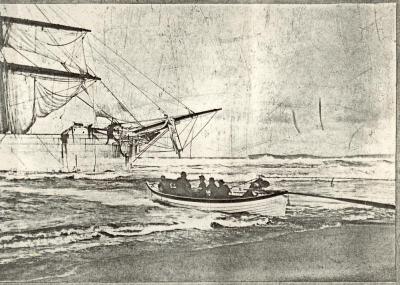
Devastating storm damage to the hard luck ship New York left her without a fore topgallant mast, topsail yard and the skysail yards on the foremast were blown awayâplus the mainmast was left without sail.
The increasingly nervous crew, whose first mate lay in his bunk seriously ill, felt certain they would never see San Francisco, and to each other they confided their fears that their lives would end right there on the high seas.
âIt took many hours hard work to get things straightened out,â? crew member Paul Scharrenberg wrote in 1901, âand as there were no extra spars aboard, we had to let her go under the new rig with a skysail on the mizzen and lower topsail on the foremast. Her steering had been bad enough before, but from that night the good ship could not be made to readily respond to her helm.â?
Gales beat up the New York until she reached Southern California, where the winds quieted down.
âIt continued this way until Sunday morning, the 13th of March,â? Claire, the ship captainâs daughter recalled, âwhen we found ourselves in the vicinity of Half Moon Bayâ¦Then a northerly wind came up, and the seas became turbulent again, swinging wildly about a ship that would not answer her helmâ¦â?
They were only one day away from San Francisco harbor, Captain Thomas Peabody assured his frightened daughter. Comforted, Claire slept an hour in her bunk until loud voices and strange noises woke her up.
The New York shivered and shook, glassware hanging in racks on the cabin wall crashed to the floor, wildly swinging lanterns flickered out.
Claire was consumed with fear as she bolted out of bed, calling for her mother. Together they scrambled up the companion way, opened the door and stood frozen in terror.
âJust then,â? Claire tells us, âa gigantic wave rolled over the ship, and she lurched wildlyâ¦â?
âGet below, both of you!â? shouted Captain Peabody. âStay there until I come down to you.â?
Two hours later Captain Peabody slipped below deck and told his wife and daughter they were aground on the sands of Half Moon Bay. When the full moon rose, he said, he planned to order the lifeboats lowered, rowing everyone to safety through the churning surf.
All day the people of Half Moon Bay had watched the twitchy movements of the ship from the beaches. Some carried whiskey, waiting on the sands near the foot of Kelly Avenue for the outcome.
At 1 a.m., First Mate Callip, still suffering from a bad âcoldâ?, and in charge of seven seamen, swung a lifeboat from the davits. Captain Peabody placed his daughter and wife in the stern of the small craft and the men were ordered to pull away from the ship. But as they neared shore, the strong undercurrents capsized the boat, tossing its occupants into the frigid waters.
When the Coastsiders saw the boat capsize, they formed a human chain, wading out into the turbulent waves, reaching for Claire and her mother, bringing them safely ashore.
As mother and daughter huddled around a blazing bonfire eating steak provided by the kindly townspeople, First Mate Callipâs impulse was to rescue those still aboard the New York. But he couldnât get help from the sailors who now were too drunk from drinking whiskey to rescue their shipmates.
Finally, a second boat was launched from the New York, bringing ten more seamen ashore. But during the launch the cook, Ah Lee, caught his leg in the craft, fracturing his knee.
As was maritime custom, Captain Peabody was the last to leave the ship.
â¦To Be Continuedâ¦
Whangpoo River, Another Time
Anniversary of the Shipwreck of the New York at Half Moon Bay: (the longer version) Part II
The T.F. Oake’s 1896-97 voyage from Hong Kong to New York harbor had been hard.
Unfavorable winds challenged the crew, and with food rationing, illness broke out among the men, leading to the death of the Chinese cook on November 11. In quick succession, five more sailors were buried at sea. The remaining crew, not including the first mate, Captain Reed and his wife, Mary, fell desperately ill with scurvy, too weak to move from their bunks.
The singular bright spot during the bleak voyage was Mary Reed’s bravery. Described as “a woman of masculine proportions”, her husband proudly called her “the best man aboard ship”. During a terrific March 1, 1897 gale, and when the Oakes was off Cape Hatteras, it was Mary Reed who singlehandedly took over the ship’s wheel, attending to the halyards and the sheets.
(Mary Reed’s heroism did not go unnoticed–Lloyd’s of London, the vessel’s insurer, awarded her a special commendation).
A few days after the Oakes limped into New York harbor, her surviving sailors filed charges against Captain Reed in U.S. District Court, claiming he willfully withheld food. At the trial, the sailors testified to his cruelty and their near starvation. The jury found Reed not guilty. Citing precedent for their decision, the jury noted it was an unusual voyage, and not unexpected that men fell ill. In a related civil lawsuit, the crew pressed charges against Reed for neglect and that he had not supplied sufficient food–a New York judge awarded the plaintiffs $2,914.
During litigation, the T.F. Oakes was sold to Lewis Luckenbach. Concerned about sailor’s reluctance to work on a ship with a shady past, her name was changed to the New York and the popular Thomas Peabody hired to captain her.
The New York’s maiden voyage form New York to Asia and San Francisco commenced on May 18, 1897. On board the ship loaded with oil were Captain Peabody’s wife, Clara, and their seven-year-old daughter Claire. Peabody brought along hs optimism: “New captain, new name, we shall be lucky,” he said.
Crew members included the tall, thin, quiet first mate, Callip, and San Mateo County resident Paul Scharrenberg, an “industrious, brown-haired, blue-eyed lad”–later director of the California State Department of Industrial Relations.
The New York plowed through the Java and China Seas and after nine months in deep water, sailed up the Whangpoo River, dropping anchor at Shanghai, where they sampled the teeming city by rickshaw, before returning to Hong Kong.
During the month-long stay in Hong Kong, bird shops fascinated young Claire, where caged monkeys jumped up and down to attract attention. On a shopping spree, Claire’s mother bought a pure white, screeching parrot with a pale green topknot. The parrot was now a part of the New York’s crew.
Preparing to sail for San Francisco, coolies loaded porcelain, silks, rice, wine, tea, peanuts, teakwood chairs and firecrackers aboard the ship. “Bright with Chinese characters”, the cargo boxes smelled of incense and spices.
On January 14, 1898, the New York sailed out of Hong Kong harbor, but “from the first day we left China unil we sighted the California coast we had a miserable time,” wrote Claire Peabody in her book, “Singing Sails” (1950).
Non-stop storms pushed and pulled the vessel. Protected by waterproofed oilskins, Captain Peabody gave orders to the crew, a crew that whispered that the New York was a doomed ship. They feared they would never see San Francisco.
Worse, the First Mate, Callip, fell ill with a “cold” that didnt’ improve; the Captain stood his watch.
Surrounded and battered by rough weather around Cape Horn, little Claire Peabody continued her on-board education, memorizing Henry Wadsworth Longfellow’s poems.
When the ship was 850 miles west of San Francisco, the crew encountered a gale so terrible that it “snared the iron ship in its teeth”. The New York rolled around helplessly in tremendous seas, often in danger of foundering.
(Document below: Lloyds of London awarded Mary Reed a medal for her courage. Click to enlarge)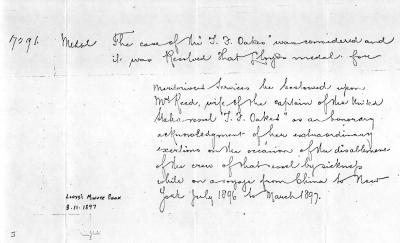
Top: Painting of the T.F. Oakes by Mary Reed, who was also known as Hannah.
…To be continued…

